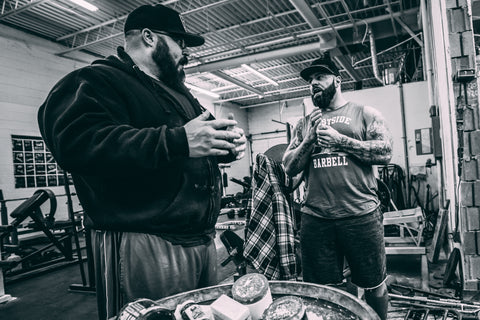Too Tough to Take Down

One of the most critical components of a grappler's skillset is the ability to defend against a takedown attempt. It doesn't matter if it is a grappling match or a fight; the ability to resist takedowns using a combination of technique and strength allows the athlete to dictate where the fight takes place and who has the advantage.
In the sport of grappling, your takedown resistance decides who has control in the match and prevents your opponent from scoring points, which could mean the difference between a win or a loss. In MMA, takedown defense is essential for fighters with a grappling background, let alone striking specialists, who must remain on their feet to fully implement their fight game plan.
So, it doesn't matter if a fighter is a pure grappler or comes from a pure striking background; it is important to develop the type of strength that will contribute to your ability to resist takedown attempts from the strongest and most skilled grapplers. If you're a competitor in combat sports, it is only a matter of time before you run into an elite-level grappler. Developing the strength necessary to deal with that is vital to your success.
Another benefit improved strength and takedown resistance provides the athlete is the ability to wear an opponent down while preserving energy. Once an athlete has developed the absolute strength necessary to provide tremendous resistance to a takedown, it will be much easier to brace and resist the opponent's effort. Meanwhile, the opponent is hunched over, wasting oxygen and energy against an immovable object.
In combat sports, skill development and technique are critical aspects of success. However, when skill and technical gaps diminish as a fighter rises up the ranks, strength, speed, and endurance decide winners and losers. Speed and endurance training are typically embraced. However, absolute strength training is often neglected.
Unfortunately, many athletes have been scared away from high-intensity barbell training. The fear of heavy barbell training has been successfully sold for many years by individuals that have no idea about or experience with heavy barbell training, but one thing they know for sure is that it's dangerous. Strength coaches often fear and disparage what they do not understand.
The development of absolute strength is critical for combat athletes. Regarding takedown defense, absolute strength will ultimately decide whether a fighter stays on their feet or ends up on the mat. At Westside, we have many exercise variations to target both the anterior and posterior strength chains while also developing the strength and durability necessary to resist takedown attempts from some of the most elite grapplers competing today.
Here are a few of the go-to exercises we use to help build absolute strength and improve a fighter's takedown defense:
Zercher Squats
We like to use the Zercher squat when training grapplers and fighters for two primary reasons; the exercise develops the posterior chain and absolute strength when loaded to proper intensity levels and trains a motor pattern similar to an underhooks position while resisting a takedown. This exercise is a great way to develop the entire back, hips, glutes, and hamstrings while improving abdominal strength and overall upper torso strength and durability.
Heavy Zercher squats are challenging, so it only makes sense they are an effective way for individuals facing harsh competition to develop their competition readiness. To perform a Zercher, we usually place the barbell so the athlete starts the lift with the knees at 90 degrees or slightly above parallel. From there, the athlete will set the feet (close = more quad, wide = more hip), make contact with the barbell by placing it in the hinges of the arms, brace the trunk, stand up, and perform a squat the same way as if the barbell was on your back.
Regarding programming Zercher squats, we like to keep them scheduled as a main exercise, working up to a top set of 1-3 repetitions. When we need to add variation to the exercise, we will change the rack height and the barbell used or add accommodating resistance to the barbell. However, if you're new to Zercher squats, you can get by just changing the rep ranges and rack height for a while.
Front Squats
Now that Zercher squats have addressed the posterior strength chain, we need to add an exercise that changes the primary focus to the anterior muscles of the lower body. Front squats are a great way to target the quads, hips, trunk, low back, mid back, and upper back.
Front squats can seem complicated to athletes new to strength training. However, the execution is relatively simple. The main aspect of front squatting that holds athletes back initially is how to grip and secure the barbell onto the chest and anterior shoulders. At Westside, our athletes will use one of three ways to secure the barbell for a front squat. These include traditional weightlifting and cross-arm grips or using a front squat harness to secure the barbell without using the arms.
The weightlifting-style grip is a good choice; however, many cannot achieve optimal positioning due to poor wrist mobility. This can be especially true with combat sports athletes who may already have hand and wrist issues due to prior injury. So, in that case, we would then move on to the cross-arm style of gripping the barbell for a front squat. While these two grips are the most common, some athletes require a front squat harness. Often, these athletes have dealt with prior shoulder injuries and cannot risk another injury.
To perform this exercise, the athlete will establish a workable grip that places the barbell on the upper chest/torso while establishing a solid trunk brace to raise the barbell out of the rack. Once standing and ready to squat, the athlete will continue to brace while keeping the chest and torso as upright as possible.
Once optimal squat depth has been achieved, the athlete will continue to brace and elevate the upper torso while reversing the barbell's path.
At Westside, we use the front squat as a main exercise, a primary accessory exercise, and an accessory exercise. We will perform a top set of 1-3 reps when used as a main exercise. We will perform 3-5 sets of 5-8 reps as a primary accessory exercise. We will perform 3-4 sets of 8-10 reps when used as an accessory exercise.
Anderson Squats
The Anderson squat was first used by the legendary Paul Anderson, a world-renowned weightlifter, powerlifter, and strongman. It is an exercise focused on developing lower body brute strength above all else. This is achieved by removing the eccentric portion of the lift. There is no energy transfer from eccentric to concentric; adequate force must be applied immediately to begin moving the barbell.
Developing brute strength, particularly at joint angles that provide you with minimal advantage, is of great benefit to the combat sports athlete. Often, athletes find themselves in difficult positions during grappling exchanges or scrambles, and situations like these can be most significantly affected by improvements in absolute strength.
If you don't have much room to move and need to get an advantage over your opponent, creating a sudden burst of force and violent movement makes all the difference when battling for position.
To perform an Anderson squat, use safety straps or chains to suspend a barbell from a rack. Ideally, the barbell will hang so the starting position forces the athlete's knees to 90 degrees or slightly below parallel. Once the barbell is set to the proper height, the execution is simple; the athlete will get under it just as they would have if they squatted it to depth. From there, the athlete will brace the trunk while driving with the legs and raising the trunk.
Once the athlete reaches lockout, they will lower the barbell back to the straps or chains in a controlled manner. Do not purposely extend this eccentric movement. However, do not allow the barbell to go crashing into the straps or chains either. Doing so can damage equipment or, worse - injure the athlete.
At Westside, we program Anderson squats as both a main and primary accessory exercise. When programmed as a main exercise, we will work up to a top set single of 1-3 repetitions. We will perform 3-5 sets of 5-8 reps when programmed as an accessory exercise. This exercise can be performed using a regular squat bar, the SSB, or a giant cambered bar.
Absolute Strength - The Deciding Factor
Nothing can mimic the tremendous benefits of barbell training performed at high-intensity levels. Not only will absolute strength increase, but you'll also increase your bone and tissue density. Add to that improved intramuscular coordination and enhanced durability and toughness; these sound like attributes that would benefit a combat sports athlete, right?
Absolute strength also decides the ceiling that limits all other strengths and abilities. You may think to run faster or jump higher, all you need to do is run more and jump more. However, the truth is an athlete's level of absolute strength ultimately decides how fast the athlete can run or how high the athlete can jump. Failure to enhance the athlete's absolute strength will eventually result in a stagnation of improvement for the athlete. This is where many wrongfully believe they have reached a "plateau."
To become the best athlete, you must become one of the strongest. Does this mean I recommend all athletes gain 50 lbs of muscle and compete in powerlifting on the side? Absolutely not. What I am suggesting is to train using weights that are high-intensity for you and get as strong as you can at your current body weight. Absolute strength development is not just necessary for strength athletes, it is necessary for all athletes.
I have said it before and will repeat it; when skill sets are equal or similar, the stronger, faster, and more athletic athlete almost always prevails. If you have to bet on a fight, and all you know about the two fighters is that they are equally skilled in martial arts, but one athlete squats 800lbs while the other squats 315lbs, who would you bet your life savings on if you were forced to?
When skill and technical ability are practically equal, as they usually are at the top of any sport, absolute strength and athleticism make the difference.
Sources:
Simmons, L. (2007). Westside Barbell Book of Methods. Westside Barbell.
Verkhoshansky, Y., & Siff, M. C. (2009). Supertraining. Verkhoshansky.





